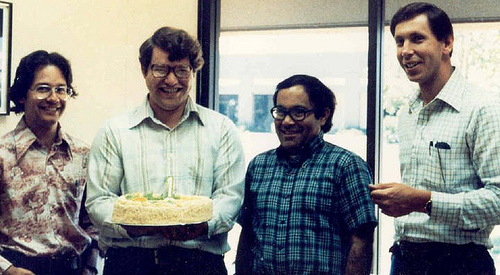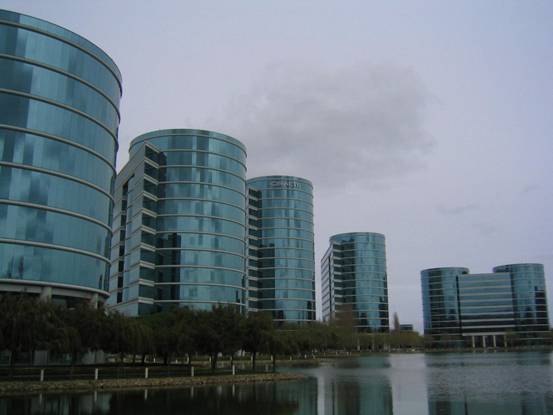A collection of 19 FAQs on creating and managing tablespaces and data files. Clear answers are provided with tutorial exercises on creating and dropping tablespaces; listing available tablespaces; creating and dropping data files; setting tablespaces and data files offline; removing corrupted data files. Topics included in this FAQ are:
- What Is an Oracle Tablespace?
- What Is an Oracle Data File?
- How a Tablespace Is Related to Data Files?
- How a Database Is Related to Tablespaces?
- How To View the Tablespaces in the Current Database?
- What Are the Predefined Tablespaces in a Database?
- How To View the Data Files in the Current Database?
- How To Create a new Oracle Data File?
- How To Create a New Tablespace?
- How To Rename a Tablespace?
- How To Drop a Tablespace?
- What Happens to the Data Files If a Tablespace Is Dropped?
- How To Create a Table in a Specific Tablespace?
- How To See Free Space of Each Tablespace?
- How To Bring a Tablespace Offline?
- How To Bring a Tablespace Online?
- How To Add Another Datafile to a Tablespace?
- What Happens If You Lost a Data File?
- How Remove Data Files befor opening a Database?
Sample scripts used in this FAQ assumes that you are connected to the server with the SYSTEM user account on the default database instance XE. See other FAQ collections on how to connect to the server.
What Is an Oracle Tablespace?
An Oracle tablespace is a big unit of logical storage in an Oracle database. It is managed and used by the Oracle server to store structures data objects, like tables and indexes.
What Is an Oracle Data File?
An Oracle data file is a big unit of physical storage in the OS file system. One or many Oracle data files are organized together to provide physical storage to a single Oracle tablespace.
How a Tablespace Is Related to Data Files?
Each tablespace in an Oracle database consists of one or more files called datafiles, which are physical structures that conform to the operating system in which Oracle is running.
How a Database Is Related to Tablespaces?
A database’s data is collectively stored in the datafiles that constitute each tablespace of the database. For example, the simplest Oracle database would have one tablespace and one datafile. Another database can have three tablespaces, each consisting of two datafiles (for a total of six datafiles).
How To View the Tablespaces in the Current Database?
If you want to get a list of all tablespaces used in the current database instance, you can use the DBA_TABLESPACES view as shown in the following SQL script example:
SQL> connect SYSTEM/fyicenter
Connected.
SQL> SELECT TABLESPACE_NAME, STATUS, CONTENTS
2 FROM USER_TABLESPACES;
TABLESPACE_NAME STATUS CONTENTS
------------------------------ --------- ---------
SYSTEM ONLINE PERMANENT
UNDO ONLINE UNDO
SYSAUX ONLINE PERMANENT
TEMP ONLINE TEMPORARY
USERS ONLINE PERMANENT
What Are the Predefined Tablespaces in a Database?
When you create a new database, Oracle server will create 4 required tablespaces for the new database:
- SYSTEM Tablespace – Every Oracle database contains a tablespace named SYSTEM, which Oracle creates automatically when the database is created. The SYSTEM tablespace is always online when the database is open.
- SYSAUX Tablespace – The SYSAUX tablespace was installed as an auxiliary tablespace to the SYSTEM tablespace when you created your database. Some database components that formerly created and used separate tablespaces now occupy the SYSAUX tablespace.
- UNDO Tablespace – UNDO tablespaces are special tablespaces used solely for storing undo information. You cannot create any other segment types (for example, tables or indexes) in undo tablespaces. Each database contains zero or more undo tablespaces. In automatic undo management mode, each Oracle instance is assigned one (and only one) undo tablespace. Undo data is managed within an undo tablespace using undo segments that are automatically created and maintained by Oracle.
- TEMP Tablespace – When the SYSTEM tablespace is locally managed, you must define at least one default temporary tablespace when creating a database. A locally managed SYSTEM tablespace cannot be used for default temporary storage.
How To View the Data Files in the Current Database?
If you want to get a list of all tablespaces used in the current database instance, you can use the DBA_TABLESPACES view as shown in the following SQL script example:
SQL> connect SYSTEM/fyicenter
Connected.
SQL> col tablespace_name format a16;
SQL> col file_name format a36;
SQL> SELECT TABLESPACE_NAME, FILE_NAME, BYTES
2 FROM DBA_DATA_FILES;
TABLESPACE_NAME FILE_NAME BYTES
--------------- ------------------------------- ---------
USERS \ORACLEXE\ORADATA\XE\USERS.DBF 104857600
SYSAUX \ORACLEXE\ORADATA\XE\SYSAUX.DBF 461373440
UNDO \ORACLEXE\ORADATA\XE\UNDO.DBF 94371840
SYSTEM \ORACLEXE\ORADATA\XE\SYSTEM.DBF 356515840
How To Create a new Oracle Data File? There is no dedicated statement to create a data file. Data files are created as part of statements that manages other data structures, like tablespace and database. How To Create a New Tablespace? If you want a new dataspace, you can use the CREATE TABLESPACE … DATAFILE statement as shown in the following script:
SQL> CREATE TABLESPACE my_space
2 DATAFILE '/temp/my_space.dbf' SIZE 10M;
Tablespace created.
SQL> SELECT TABLESPACE_NAME, STATUS, CONTENTS
2 FROM USER_TABLESPACES;
TABLESPACE_NAME STATUS CONTENTS
---------------- --------------- ---------
SYSTEM ONLINE PERMANENT
UNDO ONLINE UNDO
SYSAUX ONLINE PERMANENT
TEMP ONLINE TEMPORARY
USERS ONLINE PERMANENT
MY_SPACE ONLINE PERMANENT
SQL> SELECT TABLESPACE_NAME, FILE_NAME, BYTES
2 FROM DBA_DATA_FILES;
TABLESPACE_NAME FILE_NAME BYTES
--------------- -------------------------------- ---------
USERS \ORACLEXE\ORADATA\XE\USERS.DBF 104857600
SYSAUX \ORACLEXE\ORADATA\XE\SYSAUX.DBF 461373440
UNDO \ORACLEXE\ORADATA\XE\UNDO.DBF 94371840
SYSTEM \ORACLEXE\ORADATA\XE\SYSTEM.DBF 356515840
MY_SPACE \TEMP\MY_SPACE.DBF 10485760
So one statement created two structures: a tablespace and a data file. If you check your file system with Windows file explorer, you will see the data file is located in the \temp directory of. The data file size is about 10MB. Its contents should be blank and full of \x00 at this time.
How To Rename a Tablespace?
You can easily rename a tablespace by using the ALTER TABLESPACE … RENAME TO statement as shown in the example below:
SQL> CREATE TABLESPACE my_space
2 DATAFILE '/temp/my_space.dbf' SIZE 10M;
Tablespace created.
SQL> ALTER TABLESPACE my_space RENAME TO your_space;
Tablespace created.
SQL> SELECT TABLESPACE_NAME, STATUS, CONTENTS
2 FROM USER_TABLESPACES;
TABLESPACE_NAME STATUS CONTENTS
---------------- --------------- ---------
SYSTEM ONLINE PERMANENT
UNDO ONLINE UNDO
SYSAUX ONLINE PERMANENT
TEMP ONLINE TEMPORARY
USERS ONLINE PERMANENT
YOUR_SPACE ONLINE PERMANENT
How To Drop a Tablespace?
If you have an existing tablespace and you don’t want it anymore. You can delete a tablespace by using the DROP TABLESPACE statement as shown in the example below:
SQL> CREATE TABLESPACE my_space
2 DATAFILE '/temp/my_space.dbf' SIZE 10M;
Tablespace created.
SQL> DROP TABLESPACE my_space;
Tablespace dropped.
What Happens to the Data Files If a Tablespace Is Dropped?
If a tablespace is dropped, what happens to its data files? By default, data files will remain in OS file system, even if the tablespace they are mapped is dropped. Of course, you delete the data files using OS commands, if they are no longer needed.
Another way of deleting data files is to use the INCLUDING clause in the DROP TABLESPACE statement. Here is a SQL sample script:
SQL> CREATE TABLESPACE my_space
2 DATAFILE '/temp/my_space.dbf' SIZE 10M;
Tablespace created.
SQL> DROP TABLESPACE my_space INCLUDING CONTENTS
2 AND DATAFILES;
Tablespace dropped.
With the INCLUDING CONTENTS AND DATAFILES clause, all contents and mapped data files are also deleted.
How To Create a Table in a Specific Tablespace?
After you have created a new tablespace, you can give it to your users for them to create tables in the new tablespace. To create a table in a specific tablespace, you need to use the TABLESPACE clause in the CREATE TABLE statement. Here is a sample script:
SQL> connect SYSTEM/fyicenter
Connected.
SQL> CREATE TABLESPACE my_space
2 DATAFILE '/temp/my_space.dbf' SIZE 10M;
Tablespace created.
SQL> connect HR/fyicenter
Connected.
SQL> CREATE TABLE my_team TABLESPACE my_space
2 AS SELECT * FROM employees;
Table created.
SQL> SELECT table_name, tablespace_name, num_rows
2 FROM USER_TABLES
3 WHERE tablespace_name in ('USERS', 'MY_SPACE');
TABLE_NAME TABLESPACE_NAME NUM_ROWS
------------------------------ ---------------- ----------
MY_TEAM MY_SPACE -
EMPLOYEES USERS 107
...
How To See Free Space of Each Tablespace?
One of the important DBA tasks is to watch the storage usage of all the tablespaces to make sure there are enough free space in each tablespace for database applications to function properly. Free space information can be monitored through the USER_FREE_SPACE view. Each record in USER_FREE_SPACE represents an extent, a contiguous area of space, of free space in a data file of a tablespace.
Here is SQL script example on how to see free space of a tablespace:
SQL> connect HR/fyicenter
Connected.
SQL> SELECT TABLESPACE_NAME, FILE_ID, BYTES
2 FROM USER_FREE_SPACE
3 WHERE TABLESPAE_NAME IN ('USERS', 'MY_SPACE');
TABLESPACE_NAME FILE_ID BYTES
------------------------------ ---------- ----------
MY_SPACE 5 10354688
USERS 4 101974016
USERS 4 65536
USERS 4 65536
USERS 4 65536
USERS 4 65536
USERS 4 65536
USERS 4 65536
USERS 4 65536
USERS 4 65536
USERS 4 65536
USERS 4 65536
USERS 4 65536
USERS 4 65536
This tells us that:
- MY_SPACE has a single free extent of 10MB.
- USERS has one big free extent of 100MB, and many small free extents
of 64KB.
How To Bring a Tablespace Offline?
If you want to stop users using a tablespace, you can bring it offline
using the ALTER TABLESPACE … OFFLINE statement as shown in the
following script:
SQL> connect HR/fyicenter
Connected.
SQL> CREATE TABLESPACE my_space
2 DATAFILE '/temp/my_space.dbf' SIZE 10M;
Tablespace created.
SQL> ALTER TABLESPACE my_space OFFLINE NORMAL;
Tablespace altered.
After bringing a tablespace offline, you can backup or rename the
data file safely.
How To Bring a Tablespace Online?
If you have brought a tablespace offline, now you want to make it
available to users again, you can use the ALTER TABLESPACE … ONLINE
statement as shown in the following script:
SQL> connect HR/fyicenter
SQL> CREATE TABLESPACE my_space
2 DATAFILE '/temp/my_space.dbf' SIZE 10M;
Tablespace created.
SQL> ALTER TABLESPACE my_space OFFLINE NORMAL;
Tablespace altered.
...
SQL> ALTER TABLESPACE my_space ONLINE;
Tablespace altered.
How To Add Another Datafile to a Tablespace?
If you created a tablespace with a data file a month ago, now 80% of
the data file is used, you should add another data file to the
tablespace. This can be done by using the ALTER TABLESPACE … ADD
DATAFILE statement. See the following sample script:
SQL> connect HR/fyicenter
SQL> CREATE TABLESPACE my_space
2 DATAFILE '/temp/my_space.dbf' SIZE 10M;
Tablespace created.
SQL> ALTER TABLESPACE my_space
2 DATAFILE '/temp/my_space_2.dbf' SIZE 5M;
Tablespace altered.
SQL> SELECT TABLESPACE_NAME, FILE_NAME, BYTES
2 FROM DBA_DATA_FILES;
TABLESPACE_NAME FILE_NAME BYTES
--------------- --------------------------------- ---------
USERS C:\ORACLEXE\ORADATA\XE\USERS.DBF 104857600
SYSAUX C:\ORACLEXE\ORADATA\XE\SYSAUX.DBF 461373440
UNDO C:\ORACLEXE\ORADATA\XE\UNDO.DBF 94371840
SYSTEM C:\ORACLEXE\ORADATA\XE\SYSTEM.DBF 356515840
MY_SPACE C:\TEMP\MY_SPACE.DBF 10485760
MY_SPACE C:\TEMP\MY_SPACE_2.DBF 5242880
SQL> SELECT TABLESPACE_NAME, FILE_ID, BYTES
2 FROM USER_FREE_SPACE
3 WHERE TABLESPAE_NAME IN ('MY_SPACE');
TABLESPACE_NAME FILE_ID BYTES
------------------------------ ---------- ----------
MY_SPACE 6 5177344
MY_SPACE 5 10354688
This script created one tablespace with two data files.
What Happens If You Lost a Data File?
After you shuting down an Oracle database, you accidently deleted a
data file from the operating system. If you try to start the database
again you will get error when Oracle tries to open the database after
mounting the database. The following tutorial examples shows you what
will happen if the data file c:\temp\my_space.dbf is deleted. Oracle
can still start the database instance and mount the database. But it
will fail on openning the database as shown below in a SQL*Plus
session:
>sqlplus /nolog
SQL> connect SYSTEM/fyicenter AS SYSDBA
SQL> STARTUP
ORACLE instance started.
Total System Global Area 100663296 bytes
Fixed Size 1285956 bytes
Variable Size 58720444 bytes
Database Buffers 37748736 bytes
Redo Buffers 2908160 bytes
Database mounted.
ORA-01157: cannot identify/lock data file 5 - see DBWR
trace file
ORA-01110: data file 5: 'C:\TEMP\MY_SPACE.DBF'
SQL> SHUTDOWN;
ORA-01109: database not open
Database dismounted.
ORACLE instance shut down.
How Remove Data Files befor opening a Database?
Let’s say you have a corrupted data file or lost a data file. Oracle
can mount the database. But it will not open the database. What you
can do is to set the bad data file as offline befor opening the
database. The tutorial exercise shows you how to set two data files
offline and open the database without them:
>sqlplus /nolog
SQL> connect SYSTEM/fyicenter AS SYSDBA
SQL> STARTUP MOUNT;
ORACLE instance started.
Total System Global Area 100663296 bytes
Fixed Size 1285956 bytes
Variable Size 58720444 bytes
Database Buffers 37748736 bytes
Redo Buffers 2908160 bytes
Database mounted.
SQL> ALTER DATABASE DATAFILE '\temp\my_space.dbf'
2 OFFLINE DROP;
Database altered.
SQL> ALTER DATABASE DATAFILE '\temp\my_space_2.dbf'
2 OFFLINE DROP;
Database altered.
SQL> ALTER DATABASE OPEN;
Database altered.
SQL> col file_name format a36;
SQL> col tablespace_name format a16;
SQL> SELECT TABLESPACE_NAME, FILE_NAME, BYTES
2 FROM DBA_DATA_FILES;
TABLESPACE_NAME FILE_NAME BYTES
--------------- --------------------------------- ---------
USERS C:\ORACLEXE\ORADATA\XE\USERS.DBF 104857600
SYSAUX C:\ORACLEXE\ORADATA\XE\SYSAUX.DBF 503316480
UNDO C:\ORACLEXE\ORADATA\XE\UNDO.DBF 94371840
SYSTEM C:\ORACLEXE\ORADATA\XE\SYSTEM.DBF 367001600
MY_SPACE C:\TEMP\MY_SPACE.DBF
MY_SPACE C:\TEMP\MY_SPACE_2.DBF
At this point, if you don’t care about the data in MY_SPACE, you can
drop it now with the database opened.



